Testing Hardware Raids
Author: Peter Apian-Bennewitz, pab-opto.de,
Find below what I found while testing an Adaptec's 2400a and a 3ware 6410 under Linux 2.4.x .
I'm happy to share experience, your mileage may vary.
Setting up a fail-safe webserver, we checked some IDE Raid controllers:
Dump/passive controllers (no on-board extra CPU: Promise Fasttrak, AMI Megaraid 100) and active ones (on-board extra CPU:
Adaptec 2400a, 3ware 6410 ).
The passive ones were skipped, as it would take too long to restore an array from BIOS once the system is powered down
for disk replacement. AMI does not ship the source for their driver, so they're right out.
Both active ones appear as SCSI disks under Linux and are directly supported by 2.4.x kernels.
No hotswap hardware was tested so far.
Tests with Adaptec's 2400a ATA-raid controller on Linux 2.4.14
Raid BIOS
Allows RAID array definition and background creation. An existing drive may be used as master for a RAID-1 (mirror).
Kernel
- hardware
- dual P-II 400 on ASUS P2B-D board, 384MB ECC 100, (/proc/pci)
- software
- vanilla 2.4.14 SMP kernel compiled from scratch (.config), Adaptec: firmware 370L , SM 3.14
The standard 2.4.14 kernel recognizes the 2400a when compiled with i20 (not really needed) and Adaptec I20 RAID
(in low level SCSI drivers): (full dmesg)
SCSI subsystem driver Revision: 1.00
Loading Adaptec I2O RAID: Version 2.4 Build 5
Detecting Adaptec I2O RAID controllers...
Adaptec I2O RAID controller 0 at d8825000 size=100000 irq=5
dpti: If you have a lot of devices this could take a few minutes.
dpti0: Reading the hardware resource table.
TID 008 Vendor: HIGHPOINT Device: IDEhpt370 Rev: 00000001
TID 009 Vendor: HIGHPOINT Device: IDEhpt370 Rev: 00000001
TID 010 Vendor: HIGHPOINT Device: IDEhpt370 Rev: 00000001
TID 011 Vendor: HIGHPOINT Device: IDEhpt370 Rev: 00000001
TID 519 Vendor: ADAPTEC Device: PAB01 Rev: 370L
scsi0 : Vendor: Adaptec Model: 2400A FW:370L
Vendor: ADAPTEC Model: PAB01 Rev: 370L
Type: Direct-Access ANSI SCSI revision: 02
Attached scsi disk sda at scsi0, channel 0, id 0, lun 0
SCSI device sda: 78165248 512-byte hdwr sectors (40021 MB)
Partition check:
sda: sda1 sda2 sda3 sda4 < sda5 sda6 >
i2o_scsi.c: Version 0.0.1
chain_pool: 0 bytes @ c1670ca0
(512 byte buffers X 4 can_queue X 0 i2o controllers)
Notes:
- a standard IDE disk appears as a standard SCSI disk and is thereby accessible
- the kernel, lilo, mount etc. work as usual and don't get disturbed by the underlying RAID nature
The transition from the old IDE driver at the mainboard IDE controller to the new Raid-0 went as expected:
partition new (raid) drive, mkfs, copy stuff over, edit /etc/fstab and /etc/lilo.conf,
power-down, disconnect old drive, power up. - eh voilá.
User space
To access the raid statistics and management under Linux, the applications are installed from Adaptecs's CD.
Notes December 2002:
note 1: dptapps-3.14-2.i386.rpm is called sm_linux_v314_install.rpm on Adaptec's website.
note 2: raidtool and dptmgr work a lot better after mknod /dev/dpti0 c 151 0
Installation went smoothly, even in a non-SUSE, non-Redhat system
(Slackware 8.0, using rpm2cpio for files
and rpm -scripts -q -p dptapps-3.14-2.i386.rpm | less for scripts): raidtool command line, plus GUI (dptmgr):
(see Adaptec's side for info)
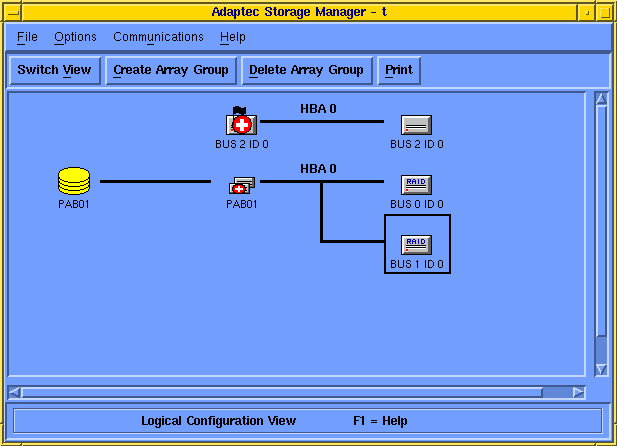
cmdline interface: raidtool -L all output
converting back to std IDE
Taking a drive out of a RAID-1 (mirror) array to attach it via standard IDE controllers is of interest if the RAID
controller should fail or for cloning a running system.
Out of the RAID-1 (mirror) array (partitioned and with ext2 filesystems), one disk was removed and attached to standard IDE controller.
fdisk recognized the partition and mounting filesystems was no problem.
Performance
Test scenario:
Three 40GB 5400rpm IDE ATA100 disks:
Seagate ST340823 (1 MB cache) ,
WDC WD400AB (2MB cache)
as Raid-1 (mirroring), plus a
Samsung SV4002H (2MB cache) as hotspare.
Sustained transfer rate is given as
"avg. min 14.5 MB/s" by Seagate,
no specs for the WD400 wre found on the WDC website.
The c't magazine measured minimal continous transfer rates [MB/s] of ST340823 (19.2), WD400AB (16.8)
and SV4002H (15.7).
Our performance tests were measured with dis_thru_put,
giving MB/sec with 1MB read/write size (64k or 32m didn't matter much). Results:
- Reading from /dev/sda2:
dis_thru_put 1m 1m < /dev/sda2 > /dev/null 2> /var/disc_timings/raw.3
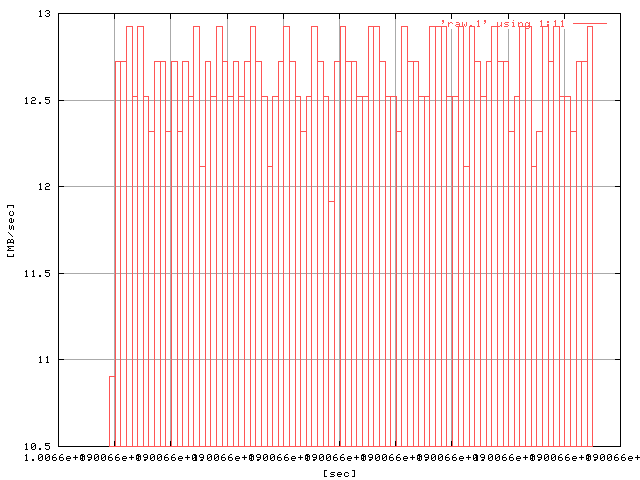
- Reading from filesystem:
dis_thru_put 1m 1m < /www/bkup/merkur.011001 > /dev/null 2> /var/disc_timings/filesys_read.4
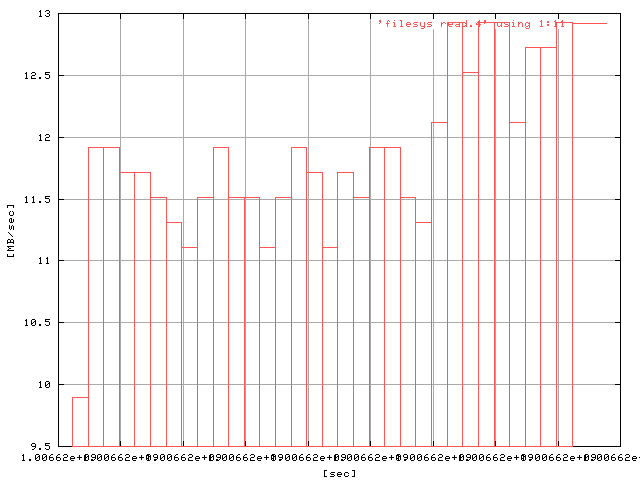
- Writing to filesystem:
dis_thru_put 1m 1m -o < /boot/test > /www/bla 2> /var/disc_timings/filewrite.3
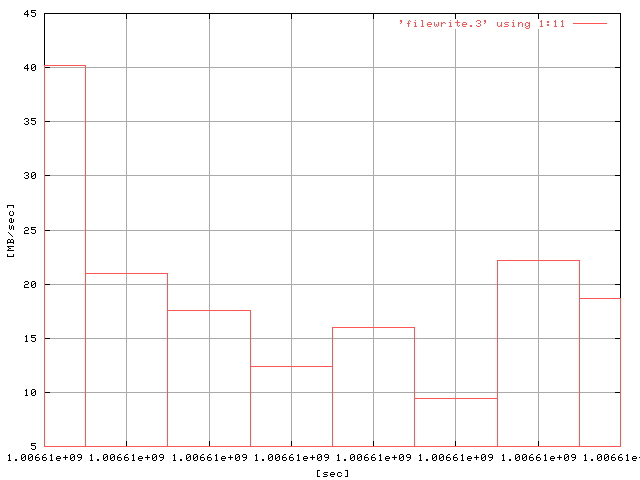
- Interference between read (read) and write (green): (Writes go to different partion than reads)
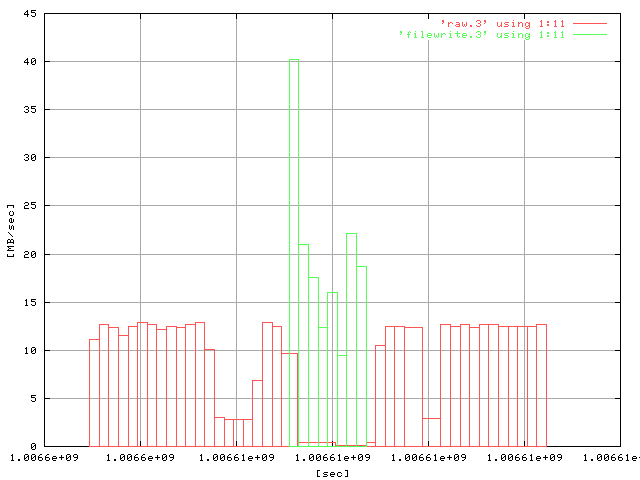
- Interference between raw read and a low level 'verify' (running on the on-board CPU), with background priority set at 50%

- Interference between raw read and drive failing (removed power from drive), with hotspare
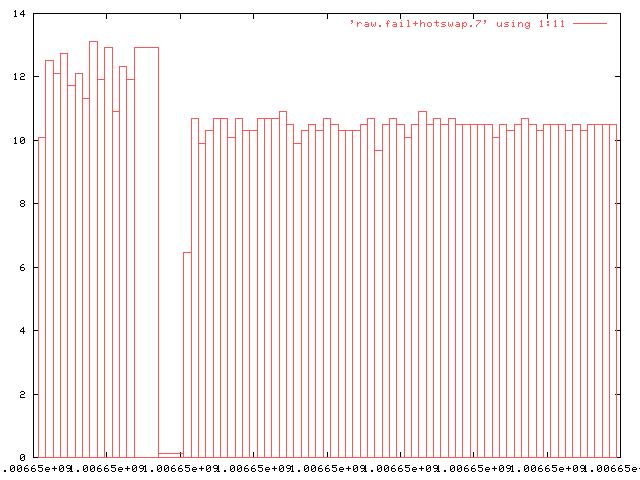
downtime about 15sec, rebuild started with hotspare automatically
rebuild took 45min for the 38166MB disks (14 MB/sec)
Results
- The 11MB/s sustained raw read speed is below disk specs.
- Write performance (approx 15MB/s) is slightly higher than read (approx 11MB/sec), probably due to the cache onboard the 2400a
- While writing to disc, reading comes to a standstill (why ?)
- during a low level 'verify' of the raid-1 the read speed drops to approx. 80% (with 50% background priority), which is ok.
- failing a drive results in a 15s break, rebuilding is 45min for 40GB (also limited by sustained data rate of disks).
- a drive can be removed from a raid-1 array and be accessed by standard IDE, which seems a good idea
any comments appreciated.
Please bark at
info@pab-opto.de in case you feel upset or interested.
updated:







